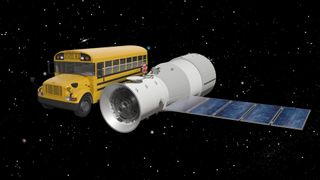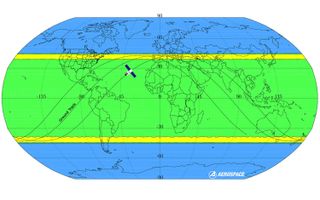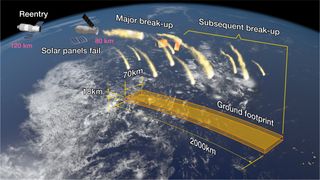
China's Doomed Space Station Did Some Science Work, Too

China's out-of-control Tiangong-1 space lab didn't just host visiting astronauts.
The school-bus-size Tiangong-1, which is predicted to crash back to Earth on Sunday (April 1), plus or minus 36 hours, was designed primarily to help China perfect the docking and rendezvous techniques needed to build a big space station. But the craft was also outfitted with scientific payloads, such as Earth-observation instrumentation and space environment detectors, according to the China Manned Space Engineering Office (CMSE).
"Tiangong-1 has obtained a great deal of application and science data, which is valuable in mineral-resources investigation, ocean and forest application, hydrologic and ecological environment monitoring, land use, urban thermal environment monitoring, and emergency disaster control," CMSE officials wrote in a 2014 statement. "Remarkable application benefits have been achieved." [China's Tiangong-1 Space Lab in Pictures]
For example, Tiangong-1 provided timely observations during China's Yuyao flood disaster in 2013 and image data during a devastating Australian forest fire, Chinese officials have said. Such information was made available to domestic and international commercial users via a paid data service, the officials added.
A productive life
The 9.4-ton (8.5 metric tons) Tiangong-1 — whose name means "Heavenly Palace 1" — helped China's blossoming human space program perfect link-up techniques as it works to piece together a larger space station for launch in the 2020s. Tiangong-1 also demonstrated short-term orbital living for crews.
The spacecraft's main body consists of two primary pieces: an "experiment module" and a "resource module." Reportedly, there is a docking mechanism at each end of the craft.
Tiangong-1 launched atop a CZ-2F booster from the Jiuquan Satellite Launch Center on Sept. 29, 2011. Serving as China's first space station, Tiangong-1 was used as a target vehicle for three rendezvous and docking missions between November 2011 and June 2013:
Get the Space.com Newsletter
Breaking space news, the latest updates on rocket launches, skywatching events and more!
- Shenzhou 8 (November 2011) demonstrated the rendezvous and docking of two uncrewed space vehicles over the course of 16.5 days.
- Shenzhou 9 (June 2012) carried three astronauts: Jing Haipeng, Liu Wang and China's first female astronaut, Liu Yang. They spent 10 days on board Tiangong-1 in a mission that evaluated automated and manual docking methods between the Shenzhou and the space lab.
- Shenzhou 10 (June 2013) was the last of the three Shenzhou missions to Tiangong-1. The three-person crew consisted of Nie Haisheng, Zhang Xiaoguang and Wang Yaping. The mission lasted for 15 days, and crewmembers carried out space medicine and scientific and technological experiments. Wang performed scientific experiments, and she taught a physics lesson to Chinese students by live television broadcast.
Tiangong-1 had a design life of two years. After the last crew visit, the space lab was placed into an extended-application phase that included use for Earth remote sensing. Tiangong-1 churned out "hyperspectral" imaging products, collecting information from across the electromagnetic spectrum, Chinese officials have said.
For several years, Tiangong-1 performed orbit-maintenance maneuvers and conducted other activities.
On March 21, 2016, space program officials in China declared that, following an operational orbit lifetime of 1,630 days, telemetry services with Tiangong-1 had ceased. That inability to keep in contact with the space lab sealed its fate, leading to the upcoming uncontrolled re-entry.
The space lab made its final orbital adjustment in December 2015, according to a detailed look at its path by researchers at the Aerospace Corporation's Center for Orbital and Re-entry Debris Studies (CORDS). [Biggest Spacecraft to Fall Uncontrolled from Space]

Powerball jackpot
Despite what you may have heard, there's not much reason to fear Tiangong-1's imminent fall to Earth, experts say.
"I would say that some media coverage has overstated the risk of Tiangong-1 harming people or property," said orbital-debris expert Andrew Abraham, senior member of the technical staff for the Aerospace Corporation.

"In reality, a few objects this size re-enter each year, and no one has been harmed by space debris to date," Abraham told Space.com. "I have calculated the odds of you personally being hit by Tiangong-1 debris to be a million times less than the odds of winning the Powerball jackpot."
Based on Tiangong-1's orbit, experts predict the lab will re-enter somewhere between 43 degrees north and 43 degrees south latitudes — basically, from Milwaukee all the way down to Tasmania.
"Yes, the inclination of Tiangong-1 does place it over the majority of populated areas for short periods of time. That being said, Tiangong-1 also flies over large areas with no people — oceans — for very large periods of time," Abraham said. "If I had to place a bet, my money would be on an ocean re-entry far from populated locations."

Watchful eye
Keeping a watchful eye on the impending re-entry is Mohammad Shawkat Odeh, director of the International Astronomical Center (IAC) in Abu Dhabi, United Arab Emirates (UAE). The Tiangong-1 ground track includes the UAE.
"We're following the re-entry date to see if there is a need to take any precautions, such as to be ready in case it will re-enter over UAE, or to close the air space at the time of re-entry if there is high probability it will fall over UAE," Odeh told Space.com.
The IAC runs a network of three stations to record astronomical events within UAE skies. Each station consists of sky-pointed astronomical cameras that automatically start recording once a meteor or a piece of space debris is detected.
As for lingering leftovers, the Aerospace Corporation's CORDS website states that "it is highly unlikely that debris from this re-entry will strike any person or significantly damage any property."
If you do come across a piece of Tiangong-1, however, CORDS researchers urge you to leave it be: "potentially, there may be a highly toxic and corrosive substance called hydrazine on board the spacecraft that could survive re-entry," the researchers wrote. "For your safety, do not touch any debris you may find on the ground nor inhale vapors it may emit."
Leonard David is author of "Mars: Our Future on the Red Planet," published by National Geographic. The book is a companion to the National Geographic Channel series "Mars." A longtime writer for Space.com, David has been reporting on the space industry for more than five decades. Follow us @Spacedotcom, Facebook or Google+. Originally published on Space.com.
Join our Space Forums to keep talking space on the latest missions, night sky and more! And if you have a news tip, correction or comment, let us know at: community@space.com.

Leonard David is an award-winning space journalist who has been reporting on space activities for more than 50 years. Currently writing as Space.com's Space Insider Columnist among his other projects, Leonard has authored numerous books on space exploration, Mars missions and more, with his latest being "Moon Rush: The New Space Race" published in 2019 by National Geographic. He also wrote "Mars: Our Future on the Red Planet" released in 2016 by National Geographic. Leonard has served as a correspondent for SpaceNews, Scientific American and Aerospace America for the AIAA. He was received many awards, including the first Ordway Award for Sustained Excellence in Spaceflight History in 2015 at the AAS Wernher von Braun Memorial Symposium. You can find out Leonard's latest project at his website and on Twitter.
